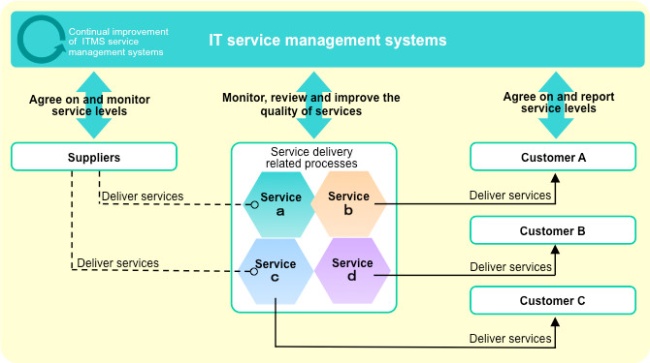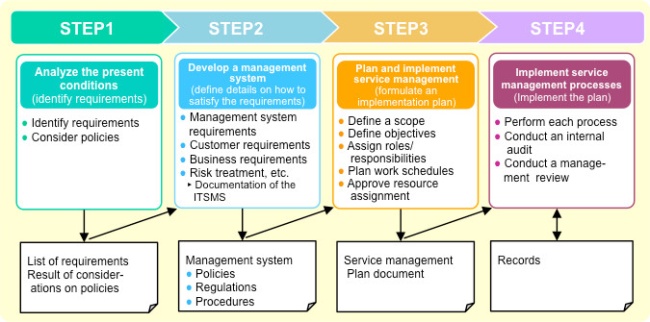Overview of ITSMS
1. What is an ITSMS?
An ITSMS (IT Service Management System) provides a framework for service providers to efficiently and effectively manage their providing IT services. By the ITSMS, it is ensured that:
[On customers] service providers agree with customers on their delivering service levels, manage service qualities according to this agreement, and report to the customers their service level conditions.
[On service delivery related processes] processes related to service delivery are controlled by service providers' service management so that the processes fulfill relevant requirements including the service levels agreed with the customers.
[On suppliers] service providers agree with suppliers on service levels (which shall be consistent with the service levels agreed by customers) to be delivered by the suppliers and monitor the suppliers based on the agreement.

2. Key factors in establishing an ITSMS
When establishing an ITSMS, it is significantly important for a service provider to:
have management's strong involvement (management commitment)
achieve a cross-sectional process approach in an organization
identify roles and responsibilities for each process and
identify inter-relationship between processes (inputs and outputs)
Set and measure service management objectives and key performance indicators (KPI) of each process
establish measurable numeric targets and measure them to "trigger" improvements
implement effective operational management procedures
apply best practices described in ITIL® etc. as appropriate,
effectively employ conventional ways and management systems for service provision, and
minimize the difference between internal regulations/rules and actual conditions
NOTE: ITIL® (IT Infrastructure Library) is a Registered Trade Mark, and a Registered Community Trade Mark, of the Office of Government Commerce (OGC) and is registered in the US Patent and Trade Mark Office.
3. Eestablishment of an ITSMS
The establishment of an ITSMS can be divided into the following four steps.

STEP1: Analyze the present conditions
Service providers analyze their present conditions (regarding compliance with the standard ISO/IEC 20000) of IT service management activities within their organizations. Based on this analysis, they identify a gap between requirements specified in the standard and their activities, and then consider policies on how to fill the gap.
STEP2: Develop management systems
In order for service providers (including their management personnel) to effectively and efficiently manage and implement their services, the standard specifies that their management systems needs to satisfy requirements in the following three areas:
・Management responsibility
・Documentation requirements, and
・Competence, awareness and training.
STEP3: Plan and implement service management
Service providers plan their service management which defines the design of service management processes necessary to achieve the service management, objectives to be achieved, roles and responsibilities of each process and relevant members, how to manage, audit and improve service quality, and process improvement cycle (ITSMS framework) applicable to any processes.
STEP4: Implement service management processes
Based on the plan formulated in STEP 3, Service providers implement the following 13 processes and "planning and implementing new or changed services" processes.
◆diams Service delivery processes
・Service level management
・Service continuity and availability management
・Budgeting and accounting for IT services
・Capacity managementt
・Information security management
◆diams Relationship processes
・Business relationship management
・Supplier managementt
◆diams Resolution processes
・Incident management
・Problem management
◆diams Control processes
・Configuration management
・Change management
◆diams Release processes
・Release management processt